ValentynVolkov/iStock/GettyImages
Salmon fillets and steaks, being naturally high in healthy fats and water, are well endowed to turn out moist and tender after cooking. For success, your most important responsibility is simply to not overcook the fish, which dries it out. Using low heat and steaming the fish in the oven is a smart way to prepare succulent salmon dishes, and the method works for all sorts of recipes. For the juiciest possible meal and extra insurance against dried-out fish, brine the salmon first.
Fill a glass baking dish with cold water. Stir in approximately 1/3 cup of kosher salt, 1/2 cup of crystal kosher salt or 1/4 cup of non-iodized table salt per 4 cups of water. If you want to marinate the salmon while you brine it, replace half the water with a suitable liquid such as soy sauce, broth, fruit juice or wine. Add a bit of sweetener and any desired herbs and spices to taste, if you like. Submerse and soak the salmon for about 20 minutes.
Preheat the oven to 250 degrees Fahrenheit while the salmon brines. Fill the bottom of a roasting pan about halfway with lukewarm water, chicken or vegetable broth or white cooking wine to steam the fish. Grease the pan's rack with cooking oil or spray and place it in the pan.
Remove the salmon from the brine and blot it dry thoroughly with paper towels. Brush it with cooking oil or melted butter; it's better to use unsalted butter if you have it, as the brine adds some saltiness. Pat on any desired seasonings, such as minced garlic, lemon or orange zest, pepper, dill, thyme, rosemary, tarragon, sage or blackening spices.
Put the salmon on the rack of the roasting pan and put it onto the middle rack of the oven. Cook it for about 20 to 25 minutes. Press into the center of the fillet or steak with a fork to test for doneness. If there's no resistance and the salmon's flesh is uniformly opaque and easily flakes, it's probably done. To be sure, insert a meat thermometer into the thickest part of the salmon; the internal temperature should be at least 145 degrees F.
Related Articles
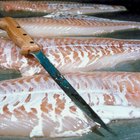
How to Grill a Cod Fish

Ways to Cook Salmon Without Butter
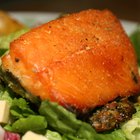
How to Brine a Grilled Salmon
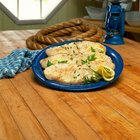
Substitutes for a Tuna Steak
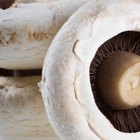
How to Cook Rockfish Fillets

How to Steam Codfish
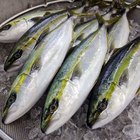
The Best Way to Smoke Yellowtail
How to Cook Atlantic Salmon Fillets
How to Cook Chilean Sea Bass Cheeks

How to Bake Mullet
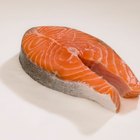
How to BBQ Salmon Fillets
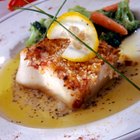
How to Pan Sear Sea Bass

How to Bake Lingcod

How to Cook Baked Speckled Trout
How to Bake Salmon So It's Tender
How to Steam Mahi Mahi Fillets
How to Cook Fresh Water Bass
How to Cook Grouper in the Oven
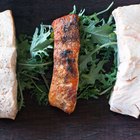
How to Cook Sea Trout

How to Cook Salmon With the Scales On
References
Writer Bio
Eric Mohrman is a food and drink, travel, and lifestyle writer living in Orlando, Florida. He has professional experience to complement his love of cooking and eating, having worked for 10 years both front- and back-of-house in casual and fine dining restaurants. He has written print and web pieces on food and drink topics for Visit Florida, Orlando Style Magazine, CrushBrew Magazine, Agent Magazine, Dollar Stretcher Magazine, The 863 Magazine and other publications.